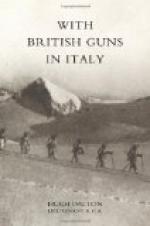We prepared another position, which was known as the “Forward” or “Battle Position,” at San Sisto, about four hundred yards behind the front line. This position we never occupied, but we should have done so, if an offensive had come from our side while we were still on the Plateau. San Sisto, I was told, was once the centre of a leper reservation. There is a little chapel there, but no other buildings. This chapel was used by the R.A.M.C. as a First Aid Post. One day I saw a shell go clean through the roof of it, but there was no one inside at the time.
The Battery O.P. was a glorious place, up a tall pine tree on the summit of Cima del Taglio, a high point to the east of the Granezza—Pria dell’ Acqua road. This O.P. had been built by the French. It was reached by a strong pinewood ladder, with a small platform half way up as a resting-place. The O.P. itself consisted of a wooden platform, nailed to cross pieces, supported on two trees. It was about fifteen feet long and four feet broad and some ninety feet above the ground. At one end of the platform a hut had been erected, with a long glass window, opening outward, on the northern side, and a small fixed glass window on the western. The other end of the platform was uncovered. When the weather was bad one could shelter in the hut and imagine oneself out at sea, as the trees swayed in the wind. The O.P. was well hidden from the enemy by the branches of the trees. The view was superb. Immediately below the thick pine forest sloped gradually downwards, the trees still carrying a heavy weight of snow. Among the trees patches of deep snow were visible, hiding rocky ground. Beyond lay the Plateau, studded with villages and isolated houses, with the ruins of Asiago in the centre of the view, and, to the left of it, the light railway line and its raised embankment, along which the Austrian trenches ran. And beyond, more pinewoods on the northern ridge, and beyond, more mountains, one snowy range behind another, up to the horizon. The visibility was often poor and variable from one minute to another. Great clouds used to sweep low over the Plateau, blotting out everything but the nearest trees, and then sweep past, and Asiago would come into sudden view again, and the sun would shine forth once more upon the little clusters of white houses, some utterly wrecked, some mere shells, others as yet hardly touched by the destruction of war. The prosaic name of this O.P. was “Claud.”
There was another O.P. called Ascot, which we used sometimes to man at the beginning. It was on, or rather in, Monte Kaberlaba, just behind the front line, approached through a communication trench and then a long tunnel through the rock, named by our troops the Severn Tunnel. This tunnel was full of water and many worse things, and it was impossible to clean it out properly. The unfortunate telephonists off duty had to live and sleep in it. The O.P. was a cramped, little, stinking place at the far end of the tunnel, shared with the Italians, undoubtedly visible and well known to the enemy, and with practically no view. The Major, by his usual skilful diplomacy, soon arranged that we should man Claud permanently, but Ascot never.




